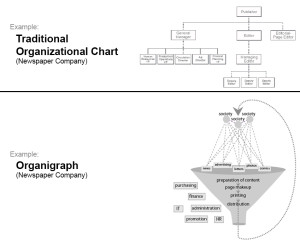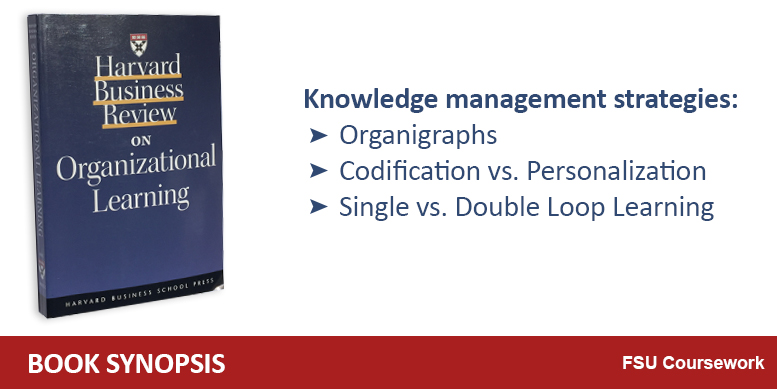The modern business environment is fast-paced, fueled by global competition and the evolving role of technology that is changing how things are done. Adaptability is a must, and as we have too often seen with the rise of the internet, disruptive technologies can rise quickly – meaning even the largest and most established organizations aren’t safe if they don’t have one eye toward the future.
Innovation comes from more places than just a research and development lab, and it is more important now than ever for managers to recognize and harness the knowledge that often organically exists within their organizations. This knowledge can be found in the hardworking and talented employees that not only do their jobs well, but can offer insights for increased performance in departments outside of their own. The book volume Harvard Business Review on Organizational Learning offers some very key insightful information on topics for managers to better approach the topic of knowledge management within their organizations, a few of which will be briefly described below.
How does my organization actually work?
All businesses have some sort of structural organization to them, and are often mapped out in the traditional hierarchical sense, or in a way that lists departments and managers to show the chain of command. While these traditional organizational charts might show who people answer to, they often do not show the interrelated links between departments or how they actually work. Authors Henry Mintzberg and Ludo Van der Heyden offer a way for managers to better visualize their organization’s functions through what they describe as organigraphs. An organigraph is an overview map of an organization that shows a company’s functions and how people naturally organize with one another within it.  Hubs and webs are introduced in order to show relationships between people and positions, and such a graph functions as a map to help show why an organization exists, what it is, and what it does. By showing how an organization works, it allows for managers to better see untapped competitive opportunities. Organigraphs offer a new way for managers to map out their organization to gain a better view of how it actually functions.
Hubs and webs are introduced in order to show relationships between people and positions, and such a graph functions as a map to help show why an organization exists, what it is, and what it does. By showing how an organization works, it allows for managers to better see untapped competitive opportunities. Organigraphs offer a new way for managers to map out their organization to gain a better view of how it actually functions.
For more information on organigraphs, read the full article by HBR here: https://hbr.org/1999/09/organigraphs-drawing-how-companies-really-work
Codification vs. Personalization Strategies.
In studies conducted across a range of companies, two common knowledge management strategies were found to be used. The codification strategy involves knowledge being codified and stored in databases by companies who sell products that are relatively standardized and fill common needs. The personalization strategy involves the sharing of knowledge through person-to-person contacts with the use of computers to help with communication, primarily in companies that provide solutions with a high level of customization to problems that are unique. Successful firms use both strategies, but focus on primarily on one and use the other in a secondary supporting role. Companies that choose to focus on the codification strategy tend to rely on reuse economics where solutions can be quickly retrieved. In contrast, those that primarily use the personalization strategy rely on expert economics where solutions are highly customized, less bulk work is done, and workers are more highly skilled and offer more of an expert knowledge. It is important for an organization’s leadership to recognize the strategy that is best for their company, and to provide the strength in order to drive the company towards choosing, implementing, and sticking to one primary knowledge management strategy.
For more information on these strategies, read the full article by HBR here: https://hbr.org/1999/03/whats-your-strategy-for-managing-knowledge
Single vs. Double Loop Learning.
In an article by Chris Agyris entitled Good Communication That Blocks Learning, some interesting concepts are introduced about interactions between management and workers, and how the methods and styles of communication can sometimes be counterproductive. Single-loop learning elicits answers that are one-dimensional by asking one-dimensional questions, while double-loop learning goes further and provides for follow-up questions that allow for productive and active learning. These concepts are important in that many styles of management and company interaction focuses on single-loop learning, which can unintentionally foster defensiveness, and limit personal learning. Single-loop learning is characteristic of the days of old when managers were in charge of manual workers – where managers were responsible for fixes and changes, and workers simply did as they were instructed. Companies that are to succeed in the future of modern business are going to need to break away from traditional company interactions of those that ask, and those that answer, and create environments where employees have the same level of organizational stewardship and intrinsic motivation to address problems as company executives.
This article is an adapted sample from a synopsis paper on Harvard Business Review on Organizational Learning, written for Advanced Topics in Project Management (COM5451) at Florida State University during the Spring of 2015.
Reference: Harvard Business Review. (2001). Harvard Business Review on Organizational Learning. Boston, MA: Harvard Business School Publishing Corporation.
